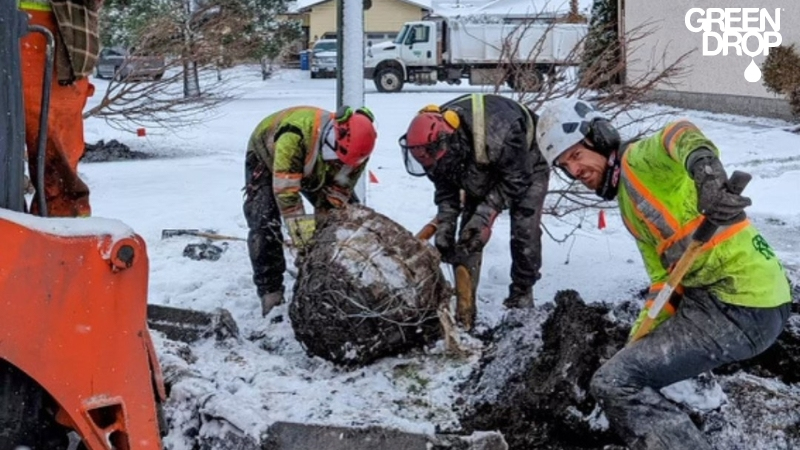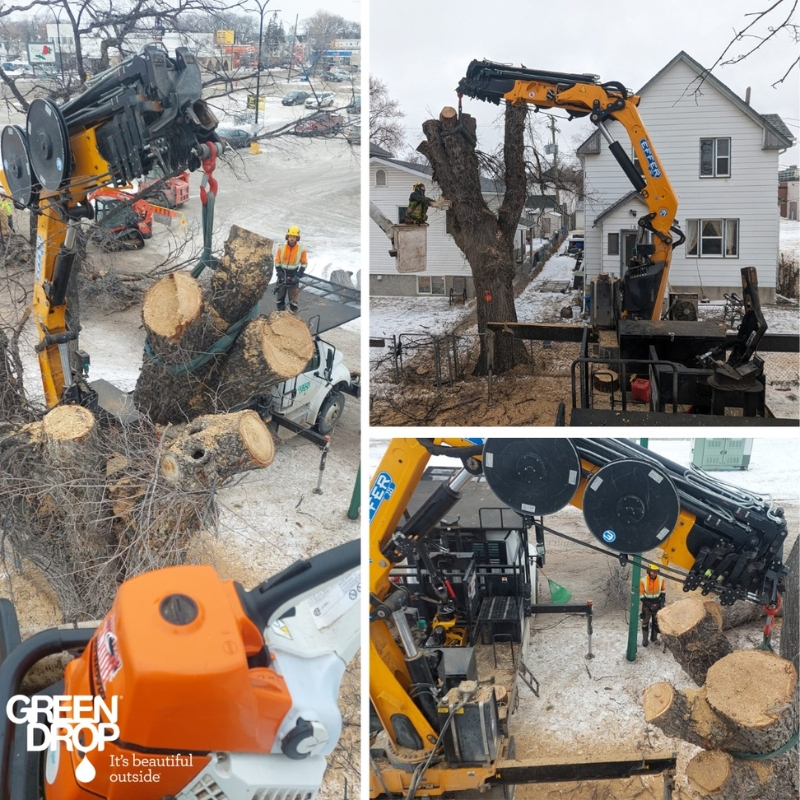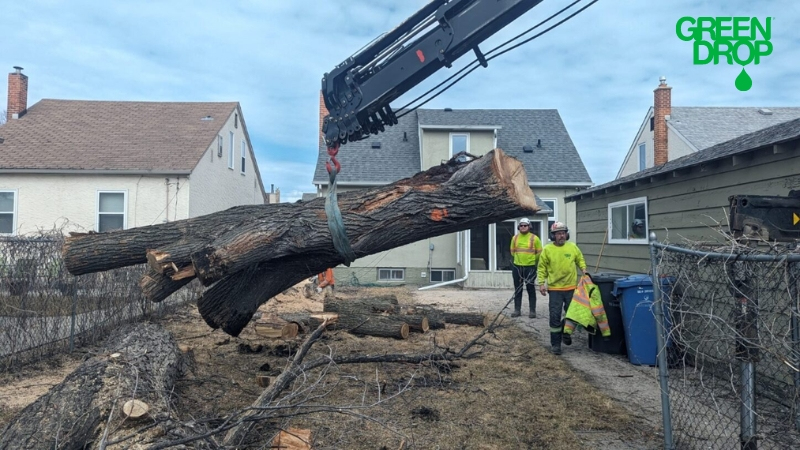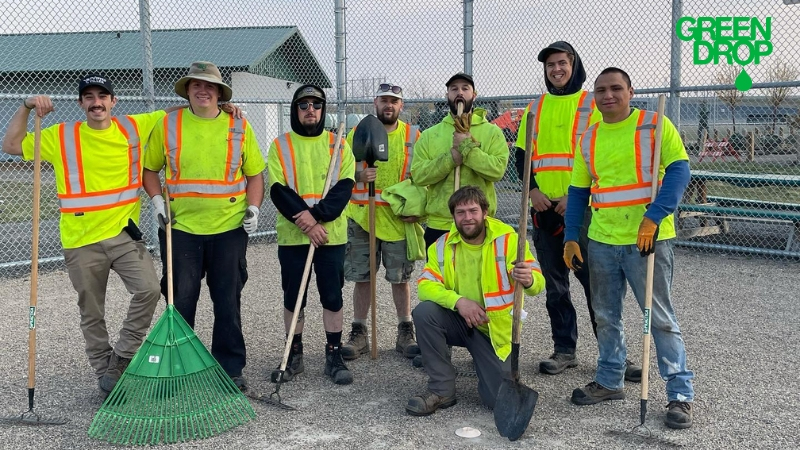The Aftermath: What to Expect After a Tree is Removed from Your Regina Property
Reading time: 7 minutesEver felt a bit of an empty nest syndrome after taking down that big old tree in your yard? It’s like saying goodbye to an old friend who’s seen better days.
While the absence might leave your landscape feeling a bit bare, sometimes it’s just necessary. Don’t worry, though, we’re here to guide you through the aftercare and transformation that follows.
We’re going to talk about how you can turn that empty space into something of new beginnings. But first…

What Are The Signs That Tree Removal is Necessary?
Sometimes, despite our best efforts to save them, trees need removal for safety, health, or aesthetic reasons. Here are some clear signs that it might be time to call in Green Drop to assess and possibly remove a tree:
- Visible Disease. Look for tell-tale signs such as fungal growth at the base, dying branches, or discoloured leaves. Diseases weaken trees, making them structurally weak.
- Structural Damage. Cracks in the trunk or major limbs, cavities, or large sections of dead wood are all red flags. These structural weaknesses could lead to the tree failing.
- Leaning. While some trees naturally lean, a sudden tilt indicates instability, particularly if there’s exposed or lifting root soil on the opposite side.
- Root Damage. Trees with damaged or rotting roots are at a high risk of falling over. Signs of root issues include mushrooms growing near the tree’s base, which indicate decay.
- Proximity to Structures. Trees that have grown too close to homes, power lines, or other structures may need removal to prevent damage. This is especially true if the tree is large and its fall could cause significant damage.
- Interference with Sidewalks or Driveways. Roots that lift pavement can create hazards and may also lead to costly repairs.
- Past Storm Damage. Trees that have sustained significant damage in storms may have hidden internal weaknesses that make them dangerous.
- Deadwood. Extensive dead branches, or a completely dead tree, are often precursors to complete failure. These need to be assessed and removed promptly to prevent potential accidents.
For more information, here’s a detailed guide on signs it's time to remove your tree.

What to Do Once a Tree is Removed
Here are a few steps to manage the aftermath of tree removal and prep it for replanting:
1. Site Clean-up
After the tree removal, a significant amount of sawdust and small debris will likely remain. Post-tree removal and managing the leftover debris is key to restoring the aesthetics and safety of your property. We begin the clean-up by systematically gathering all the scattered debris, including branches, leaves, sawdust, and wood chips.
It's crucial to follow local guidelines for organic waste disposal. Proper disposal prevents environmental contamination and keeps your property pristine and safe.
2. Addressing the Tree Stump & Root
Unless you opt for stump grinding or removal, the tree stump and root system will remain. Over time, the stump may decay, but it can also be an eyesore or a tripping hazard. So it’s best to consider stump grinding or complete stump removal.
Stump Grinding – This involves using a machine to grind the stump down to below ground level. This process removes the visible part of the stump and allows you to reclaim the space for other uses.
Stump Removal – This, on the other hand, is a more intensive process that involves excavating the stump and the root system. It’s typically more costly but removes all traces of the tree. Removing the stump may be essential not only to reclaim your space but also to prevent it from becoming a home for pests. It can also allow you to plant a new tree or shrub in its place without the risk of regrowth of the older tree, which, with grinding, is unlikely but not entirely impossible.
Take a look at our guide to see whether stump grinding or removal is right for you.
3. Soil and Landscaping
Once a tree is removed, the soil where the tree once stood may settle over time. You might need to fill in the area with additional soil or mulch to level it out.

4. Enhancing Soil Health
After tree removal, the soil left behind often needs rehabilitation to support new plant life. The removal process can compact soil and diminish its nutrient profile, particularly if the tree was diseased or treated.
To revitalize this soil, start by loosening the compacted earth with a garden fork, promoting better aeration. Enrich the area by mixing in generous amounts of organic compost or biochar, which will restore nutrient levels and enhance soil structure.
This step is crucial for creating a foundation that will support whatever you choose to plant next, whether it's grass, flowers, or a new tree.
5. Rehabilitation of the Site
Once a tree is removed, the landscape can look startlingly bare. Begin by levelling the area with topsoil to fill any depressions or voids left behind. This not only enhances the appearance of your yard but also prevents water accumulation that could lead to further problems.
Consider your long-term vision for this space: Is it a lush lawn, a vibrant garden, or perhaps another tree? If opting for grass, choose a seed blend that matches your existing lawn and apply it evenly to ensure seamless growth.
For gardens or new trees, select species that will thrive in your local climate and soil conditions, enhancing your property's biodiversity and aesthetic.

6. Preventing Future Issues
Choosing the right tree varieties is key to avoiding future complications. In Regina, consider hardy species like the Amur Maple, Bur Oak, or Siberian Elm, which are well-suited to the local climate and less prone to disease or excessive growth.
Regular monitoring of your trees is crucial. Inspect them seasonally for signs of disease or structural problems. Early detection allows for early management of potential issues.
By maintaining vigilant care and choosing appropriate species, you can ensure your landscape remains healthy and vibrant, minimizing the need for future removals.
7. Prepare for Sustainable Landscaping
Embracing sustainable landscaping transforms your yard into a vibrant ecosystem that supports local wildlife and promotes biodiversity. By choosing native plants like the prairie crocus, wild bergamot, and Saskatoon berries, you align with Regina's natural ecological patterns.
These species are well-adapted to the local climate, requiring less water and minimal upkeep compared to non-native varieties. Such practices not only create stunning visual appeal but also play a crucial role in sustaining local wildlife, from pollinators to birds.
This approach not only beautifies your space but also fortifies the health of your local environment, making your garden a haven for nature and a model of ecological responsibility.
8. Implement Proper Drainage
Removing a tree can alter the water dynamics of your property. Let’s address these changes to prevent water accumulation that could lead to soil erosion or foundation problems.
Installing French drains or creating rain gardens are effective strategies for managing excess water. French drains can redirect water away from your home and garden areas, while rain gardens utilize native plants and natural depressions to absorb and filter runoff.
9. Legal Considerations and Permissions
When removing a tree from your property and planning what comes next, it’s crucial to stay informed about local bylaws and obtain the necessary permissions.
Regina has specific regulations regarding tree removal, especially for heritage or street trees. Similar considerations apply to replanting or undertaking significant landscaping changes. It’s important to consult with your local city or municipal office to secure any required permits.
This step not only ensures that your landscaping efforts are legal but also helps avoid potential fines and ensures that your property improvements are in compliance with local urban planning guidelines.

Log Off and Start Fresh with Green Drop
After waving goodbye to your old tree, it's time to embrace the new landscape opportunities that lie ahead. Whether you're thinking about replanting, adjusting your garden layout, or implementing sustainable practices, Green Drop is here to help.
Our team of expert, ISA-certified arborists can guide you through every step post-removal, ensuring your property not only recovers but thrives.
Don’t leave your yard to fate—contact us today to explore our tree care services and get your slice of nature looking top-notch again. Book now, and let’s plant the seeds for a flourishing future!
Green Drop provides tree care services in Western Canada from Regina to Calgary, Edmonton, Red Deer, Saskatoon, and Winnipeg.

